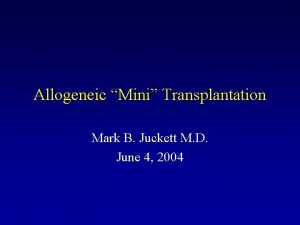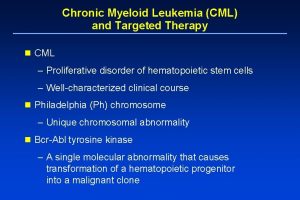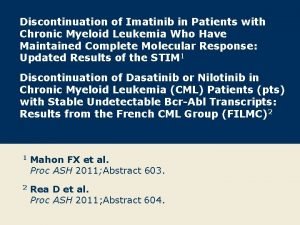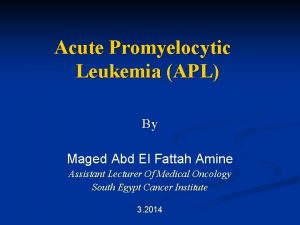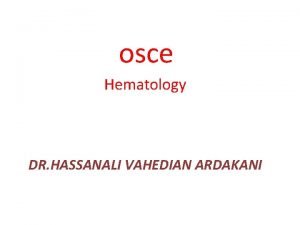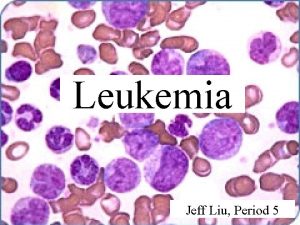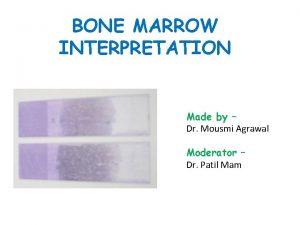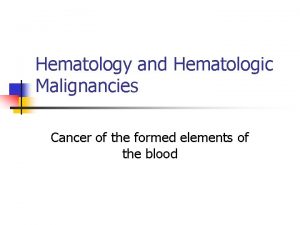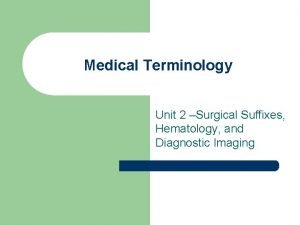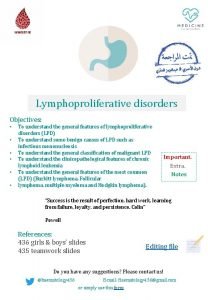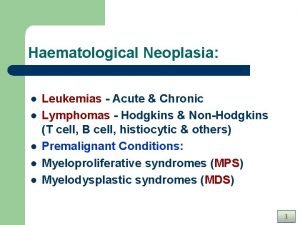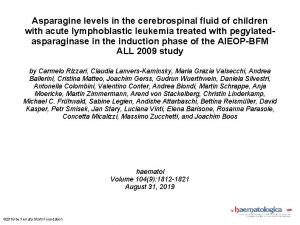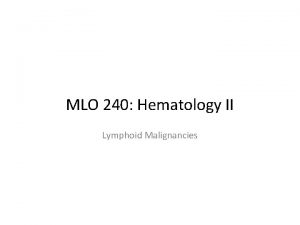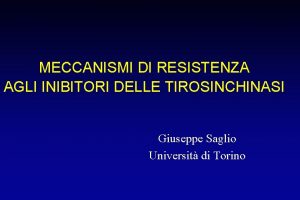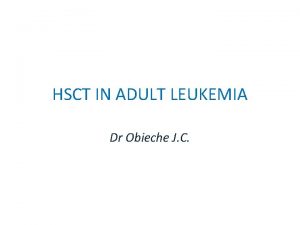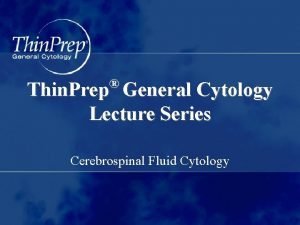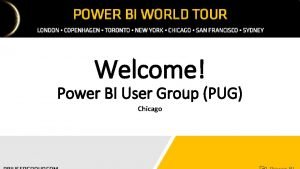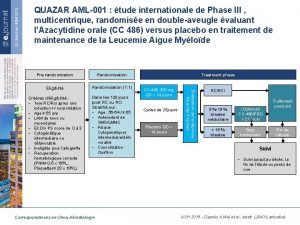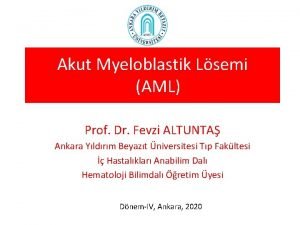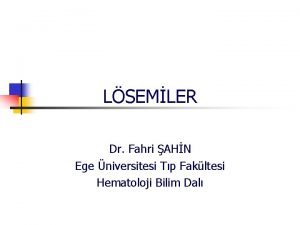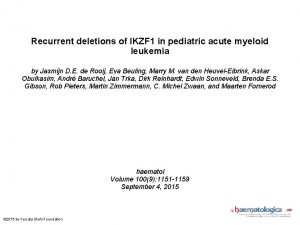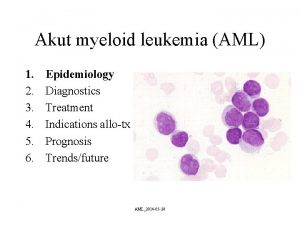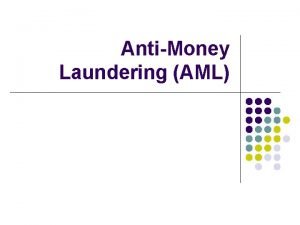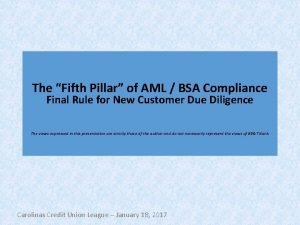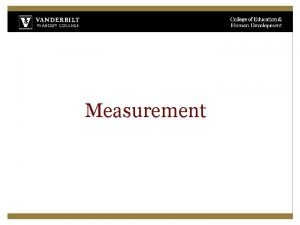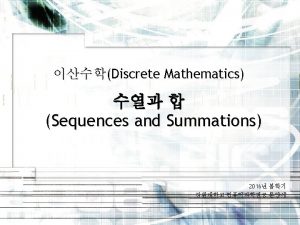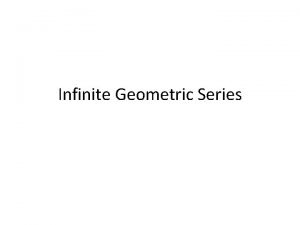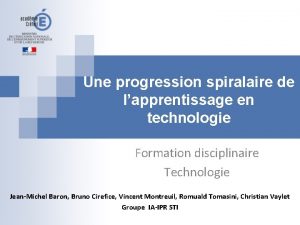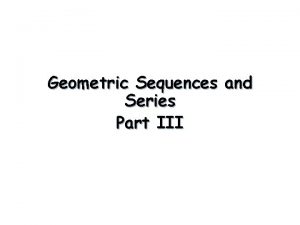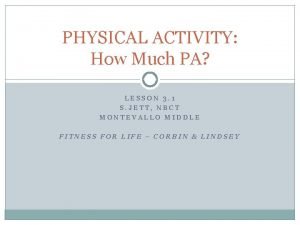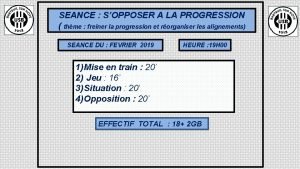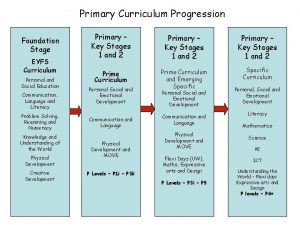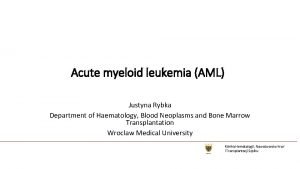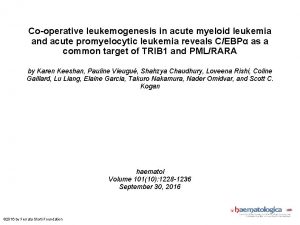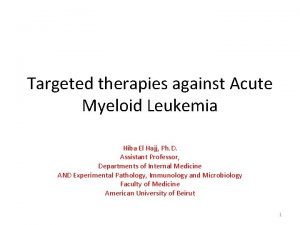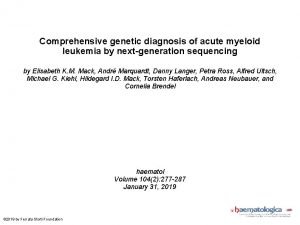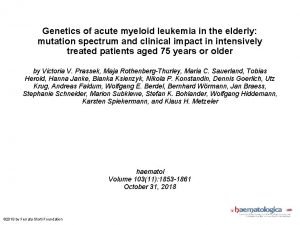acute myeloid leukemia AML AML Progression to acute































































- Slides: 63










급성 골수성 백혈병 (acute myeloid leukemia; AML)



원인 • AML의 발병원인을 밝히는 것은 대부분의 환자에서 불가 능하나, 유전성 소인, 방사선조사, 화학약품 등에 대한 직 업성 노출과 항암제 등 치료약제들이 원인이 될 수 있는 것으로 알려지고 있다. • “Progression to acute leukemia may require a series of genetic events beginning with clonal expansion of a transformed leukemic stem cell. The specific mutational event(s) required for this progression are not currently well defined. ”









Cytochemistry (세포화학적) • Myeloperoxidase (MPO) • Sudan black B (SBB) • non-specific esterase (NSE)

FAB classification M 0 The blasts lack differentiating features and were nonreactive to Sudan Black B and myeloperoxidase staining. More than 20 percent of the blasts expressed myeloid antigens CD 13 and CD 33. The blasts were terminal transferase negative and nonreactive with antibodies to lymphocytes. Auer rods were not found.

FAB classification M 1 The majority of cells have a rim of pale to slightly basophilic agranular cytoplasm. The nuclei have finely dispersed chromatin and prominent nucleoli.

FAB classification M 2 The WBC count was 70, 000/ L and was comprised almost entirely of myeloblasts with numerous azurophilic granules.

FAB classification M 3 The cell in the top center and far left are "faggot" cells, with numerous intertwining Auer rods (arrows).

FAB classification M 4 EO Bone marrow smear from a patient with acute myelomonocytic leukemia with increased marrow eosinophils (FAB classification M 4 EO) and an associated inv(16) chromosome abnormality. (Wright-Giemsa stain). The two eosinophilic precursors in this field (arrows) show prominent basophilic-staining granules.

FAB classification M 5 B Bone marrow smear from a patient with acute monocytic leukemia with maturation (FAB M 5 B). This field shows a range of maturation of monocytic cells.

FAB classification M 6 Bone marrow smear from a patient with erythroleukemia (FAB classification M 6). A megaloblastoid erythroblast (blue arrow) is shown along with three myeloblasts (black arrows).

FAB classification M 7 Bone marrow smear from a patient with acute megakaryoblastic leukemia Panel A shows large blasts and promegakaryocytes; the latter cells are larger than the blasts and have coarse nuclear chromatin and irregularly shaped nuclei (Wright. Giemsa stain). Panel B shows staining of these cells with a monoclonal antibody to platelet glycoprotein IIIa (CD 61).

Immunophenotype (면역표현 형)







급성 림프구성 백혈병 (acute lymphocytic leukemia; ALL)

개요 • ALL의 예후는 intensive induction-consolidationmaintenance regimens에 의해서 현저히 향상 • 어린이의 경우 complete remission rate는 90%이상, cure rate는 70%에 이르나, 어른의 경우 다소 낮아서 CR 은 65 -85%, cure rate는 25 -35%


• Classification of ALL

ALL The cells are heterogeneous in size, have round or convoluted nuclei, high nuclear/cytoplasmic ratio, and absence of cytoplasmic granules.

치료 1. Induction phase (관해유도요법) 2. Consolidation-Intensification (공고요 법) 3. CNS prophylaxis (중충신경계예방요법) 4. Maintenance phase (유지치료)

골수이식 ① Allogeneic BMT in first remission – first remission 상태의 성인 ALL 환자에 대한 치료 – 재발되었거나 혹은 high-risk group의 환자는 allogeneic BMT로써 disease-free survival을 향상시킬 수 있음 – chemotherapy만으로는 relapse의 위험이 큰 환자군(Ph+disease, high leukocyte counts, longer time to achievecomplete remission 등)에 한하여 권고 ② Autologous BMT in first remission – 현재까지는 autologous BMT의 효과는 미정 ③ Matched Unrelated Donor Transplantation – graft-versus-host disease(GVHD)와 graft rejection이 증가하는 반면, graft-versus-leukemia effect에 의해서 relapse의 위험이 감소


만성 골수성 백혈병 (Chronic myeloid leukemia; CML)






PBS in CML Atlas of Hematology



Imatinib mesylate (Gleevec®, Glivec. TM; STI 571) • 새로운 모델을 제시 • 현재 처음 치료에 있어 표준 요법으로 인정 • 주 부작용은 myelosuppression이며 이 외에 fluid retention, nausea, muscle cramps, diarrhea, skin rash 등





만성 림프구성 백혈병 (chronic lymphoid leukemia; CLL)



 Mark juckett md
Mark juckett md Cml stages
Cml stages Chronic myeloid leukemia
Chronic myeloid leukemia Chronic myeloid leukemia
Chronic myeloid leukemia Differentiation syndrome
Differentiation syndrome Heinz bodies
Heinz bodies Acute mylogenous leukemia
Acute mylogenous leukemia Myeloid tissue is a type of
Myeloid tissue is a type of Myeloid metaplasia
Myeloid metaplasia Sites of bone marrow
Sites of bone marrow Hairy cell leukemia
Hairy cell leukemia Lymphoma vs leukemia
Lymphoma vs leukemia Graph suffix medical terminology
Graph suffix medical terminology Leukemia
Leukemia Leukemia aleukemik adalah
Leukemia aleukemik adalah Lll leukemia
Lll leukemia Leukocyte alkaline phosphatase increased
Leukocyte alkaline phosphatase increased Clast root word
Clast root word Asparagine
Asparagine Leukémia wikipédia
Leukémia wikipédia Leukemia
Leukemia Sudan black b stain principle
Sudan black b stain principle Zhang wang leukemia
Zhang wang leukemia Leukemia conclusion
Leukemia conclusion Nk leukemia
Nk leukemia Leukemia statics
Leukemia statics Leukemia death rate
Leukemia death rate Aml workbench
Aml workbench Aml001
Aml001 Aml diş eti hipertrofisi
Aml diş eti hipertrofisi Icb aml
Icb aml Azure machine learning workbench
Azure machine learning workbench Myelositer seri
Myelositer seri Aml symptoms
Aml symptoms Pediatric aml
Pediatric aml Mastercard aml
Mastercard aml Aml program assessment
Aml program assessment Event driven review aml
Event driven review aml Aml survival by age
Aml survival by age Aml textil
Aml textil Antimoney laundering
Antimoney laundering Cdd pillar of aml prong
Cdd pillar of aml prong Difference between progress and progression
Difference between progress and progression Digital technologies victorian curriculum
Digital technologies victorian curriculum Exemple de progression pédagogique bts
Exemple de progression pédagogique bts Sum of geometric progression
Sum of geometric progression The basic principles of training
The basic principles of training Geometric series formula
Geometric series formula Dating god's way
Dating god's way Plan prodaje primer
Plan prodaje primer Pédagogie spiralaire
Pédagogie spiralaire National numeracy learning progressions
National numeracy learning progressions Progression points victorian curriculum english
Progression points victorian curriculum english Read write inc parents
Read write inc parents Principle of progression in physical education
Principle of progression in physical education Thematische progression
Thematische progression Sum of gp
Sum of gp Arithmetic sum formula
Arithmetic sum formula Arithmetic progression in gearbox
Arithmetic progression in gearbox Reading skills progression chart
Reading skills progression chart The principle of progression states that
The principle of progression states that S'opposer à la progression
S'opposer à la progression Eyfs curriculum progression
Eyfs curriculum progression Defense tackling drills
Defense tackling drills
